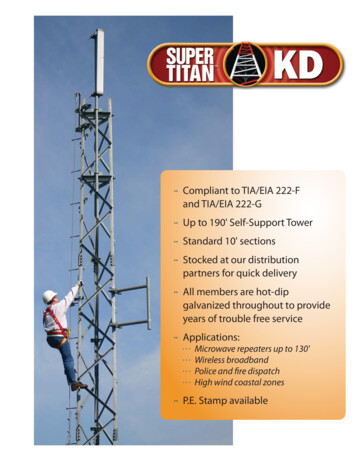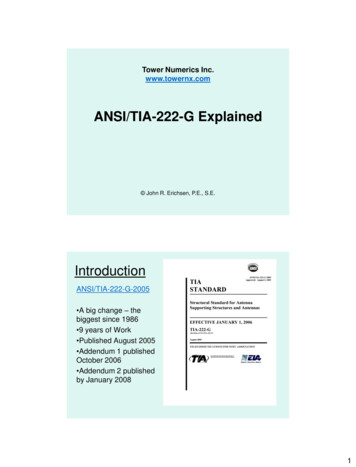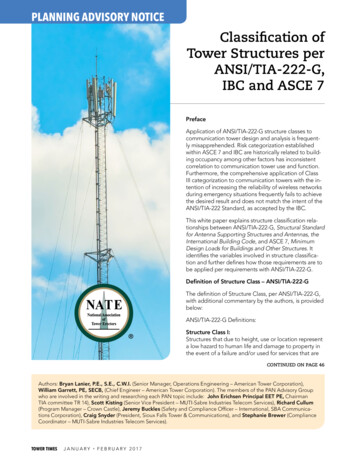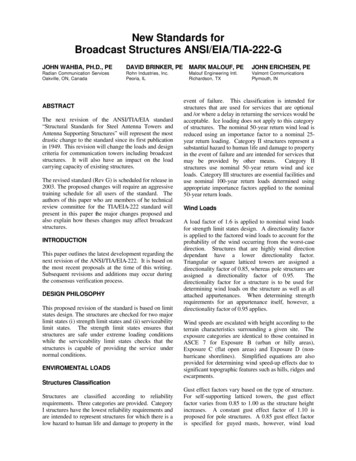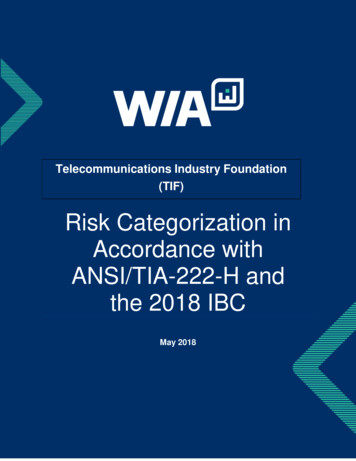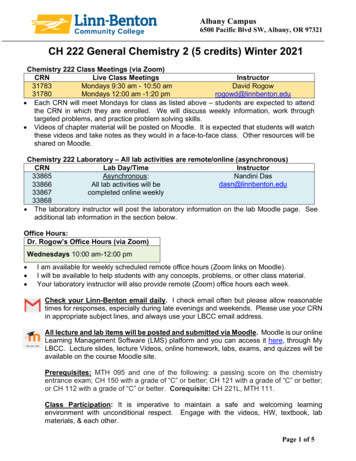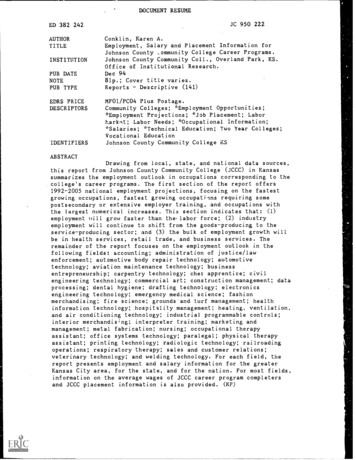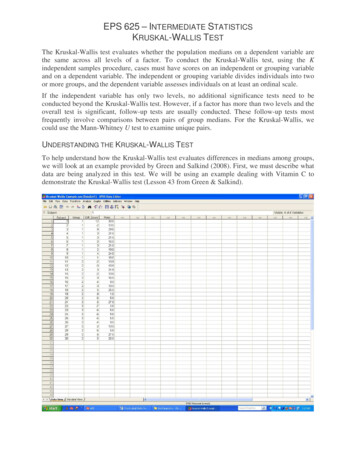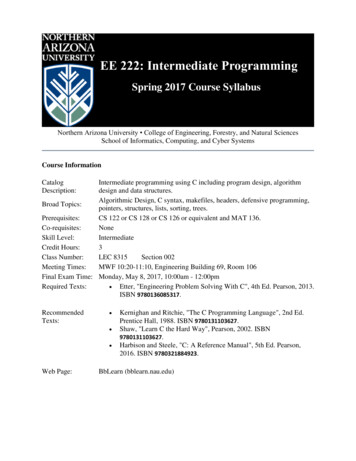
Transcription
EE 222: Intermediate ProgrammingSpring 2017 Course SyllabusNorthern Arizona University College of Engineering, Forestry, and Natural SciencesSchool of Informatics, Computing, and Cyber SystemsCourse InformationCatalogDescription:Intermediate programming using C including program design, algorithmdesign and data structures.Algorithmic Design, C syntax, makefiles, headers, defensive programming,Broad Topics:pointers, structures, lists, sorting, trees.Prerequisites:CS 122 or CS 128 or CS 126 or equivalent and MAT 136.Co-requisites:NoneSkill Level:IntermediateCredit Hours:3Class Number:LEC 8315Section 002Meeting Times:MWF 10:20-11:10, Engineering Building 69, Room 106Final Exam Time: Monday, May 8, 2017, 10:00am - 12:00pmRequired Texts: Etter, "Engineering Problem Solving With C", 4th Ed. Pearson, 2013.ISBN 9780136085317.RecommendedTexts: Web Page:Kernighan and Ritchie, "The C Programming Language", 2nd Ed.Prentice Hall, 1988. ISBN 9780131103627.Shaw, "Learn C the Hard Way", Pearson, 2002. ISBN9780131103627.Harbison and Steele, "C: A Reference Manual", 5th Ed. Pearson,2016. ISBN 9780321884923.BbLearn (bblearn.nau.edu)
Instructor InformationInstructor:Office Hours:Email:Phone:NAU Address:Patrick Kelley, BSCSEngineering Bldg. Rm 243M, W, F 8:00 - 10:00Tu,Th8:00 - 12:00Tu,Th1:00 - 3:00Patrick.Kelley (at) nau.eduorwebmaster (at) flion.com699-7455 (email preferred)Box 15600Flagstaff, AZ 86011Course DescriptionBeginning with a review of basic program design and programming style, we will explorewriting programs in C. The student will learn to write structured programs, use makefiles tobuild applications, and use headers to organize their code. C language features such as pointersand structures will be covered and the end of the semester will introduce some basic datastructures such as linked lists and trees, along with some common tools such as sorting andsearching.Course ObjectivesBy the end of the semester you should be able to: Develop an algorithmic solution to a problem.Translate an algorithm into C code.Use the C compiler and GNU debugger.Create an organized project using makefiles and header files.Use data types, pointers, and structures correctly.Produce working C code to implement linked lists, stacks, and trees.Implement sorts and searches in C code.Specific learning outcomes are detailed at the end of this syllabus.
CourseworkThe coursework includes the following assignments and tests: Homework AssignmentsHomework assignments involve research using book and online resources to answerspecific questions. They help to fully prepare you for and familiarize you with the currentlecture topics. Points are awarded for correct answers. Programming ProjectsProgramming projects are where you put the knowledge you've gained into practice,transitioning from the theoretical to the practical with hands-on experience. Points areawarded based on the completeness and quality of your work and the thoroughness ofyour project report. 1 Midterm Exam1 Final ExamThe midterm and the final are an incentive for you to ensure you fully understand thetopics being covered - as well as demonstrating that fact to the instructor. Points areawarded for correct answers.Your class grade is based on the standard scale of points earned: 90% A, 80% B, 70% C,60% D, below 60% F. No grades are curved or dropped, though there are opportunities forextra credit. Projects are individual effort.Assignments are due according to the posted schedule in Bb Learn.Extra CreditThere will be a number of extra credit possibilities that involve doing extra work on assignments.Besides that, you can also get 2 points on any project by turning it in at least two days early (ex.If it is due midnight Friday, then it must be in by midnight Wednesday to qualify for extra credit).Note that your project must fully work to receive the extra credit.Late PolicyProject assignments are accepted up to a week late at a pro-rated 40% point penalty. Otherassignments are not accepted after the due date.If you miss a test or know you will miss an assignment or test, discuss the matter with me assoon as possible. Preferably beforehand so we can make other arrangements.
AttendanceRegular attendance is expected. Don't be late, and don't leave until class is dismissed. Roll isn'ttaken, but each lecture you miss seriously jeopardizes your overall comprehension of thematerial and your chances to do well. Not to mention that this class will be blended, meaningthat some of your project work will be done together during the class period.Final Exam Policies If you score less than 50% on the final exam, your final class grade (which includes thefinal exam grade) will be reduced by one letter grade. This means that doing very poor onthe final can severely hurt your class grade. If you had 480/480 points ("A") before thefinal and made 50/120 points on the final, your final class average would be 530/600(88%) and your final grade would be "C".The final exam is mandatory to receive a passing grade in the course. Even if you arecarrying an "A" before the final, skipping the final will result in a failing grade.Lectures and the BookThe lecture topics follow the same general outline as the books. However, the lecturecomplements the book rather than being a mirror of it. If you only read the book or only payattention to the lecture you're likely to end up missing some key concepts. To get the most fromthe class, read each chapter before we discuss the corresponding topic in the lecture, then use thelecture as an opportunity to reconsider the key points of the material and ask questions onanything you're confused on.Plagiarism and CheatingGrades are a way to motivate students and to evaluate students' mastery of a subject and theirability to get work done. The grades you get are not themselves truly important, but instead arerepresentative of your knowledge, capabilities, and work ethic, and those are the things thatmatter. If you plagiarize source code, fabricate results, make fraudulent claims, or attempt tocheat in any way, you are misrepresenting yourself, your level of understanding, yourcapabilities, and your ability to accomplish things. It is dishonest and unethical.Anyone who plagiarizes, copies, fabricates, or cheats will at the least receive a zero on thatassignment or test.Consulting with others and using their advice on projects is fine. However, the programs yousubmit should be your own work that you thoroughly understand and are entirely responsible for.Don’t share code, just ideas.
Bb LearnMost assignments and handouts will only be available on Bb Learn - they will not be handed outin class. Any clarifications, corrections, and announcements will be posted on Bb Learn.I expect every student to follow the class progress in Bb Learn. Assignments and projects willbe handed in via Bb Learn and your grades will be posted there. Read the assignment policies athttp://www.cefns.nau.edu/ pek7/Common/assignment.pdf to see how I expect work to besubmitted. Failure to follow the guidelines will affect your grade.University PoliciesThere are a number of university policies that govern your education and safety that all studentsshould be aware of. These are: Safe Working and Learning EnvironmentStudents With DisabilitiesAccommodation of Religious Observance And PracticeInstitutional Review Board (And Use Of Human Subjects)Academic DishonestyMedical Insurance Coverage For StudentsClassroom ManagementEvacuation PoliciesYou will find a complete description of each policy here:http://www.cefns.nau.edu/ pek7/Common/policies.pdf
EXTENDED COURSE DESCRIPTION1. Explanation of PrerequisitesCS 122, CS 128, or CS 126 An ability to program alone and with a team. An ability to solve small to medium sized problems with structuredprogramming. An ability to employ the software design process and software design tools tosolve problems with computation.MAT 136 An ability to use applied mathematics and logical thinking.2. Core Topics Algorithmic DesignProgramming Basicso C program structureo Programming Styleo Makefileso Debuggingo Converting an algorithm to codeC Syntaxo Data types Basic types Arrays Stringso Operationso Control Structures Conditional Loops Functionso C Features Pointers Allocating and Deallocating memory Defined types StructuresData Structureso Linked Listso Queueso Stackso Treeso Sortso Searches
3. ToolsTools used in this class include: Linux (XSession from the lab computers or Remote Desktop) GCC (Note: NOT G ; we are not using C in this class) GDB EMACSNote: It is beneficial to learn to work in a simple environment without an IDE. Thus,use of an IDE is discouraged and there will be no support for them, or other tools, inthe classroom environment.4. Learning OutcomesL1. An ability to design and implement algorithms.By the end of this course students should be able to:a. Develop and test an algorithm for simple problems.b. Implement and algorithm in code.c. Test an implementation for correctness.This outcome supports BSCS ABET Student Outcomes A, E and K.This outcome supports BSACS ABET Student Outcomes A, E and K.This outcome supports BSEE ABET Student Outcomes A, C, E and K.L2. An ability to generate reports reflecting progress on assigned projects.By the end of this course students should be able to:a. Write and organize a report in a clear and engaging manner.b. Describe in writing the project outcomes.This outcome supports BSCS ABET Student Outcome G.This outcome supports BSACS ABET Student Outcome G.This outcome supports BSEE ABET Student Outcome G.L3. An ability to create organized ANSI C projectsBy the end of this course students should be able to:a. Use makefiles to handle dependancies.b. Use header files to assist code organization.c. Use basic C data types correctly and appropriately.d. Use C control structures correctly and appropriately.e. Create and call functions correctly.f. Compile and link multiple code files to a single executable.This outcome supports BSCS ABET Student Outcomes E and K.This outcome supports BSACS ABET Student Outcomes E and K.This outcome supports BSEE ABET Student Outcomes E and K.
L4. An ability to test and debug C codeBy the end of this course students should be able to:a. Create unit test code for their C projects.b. Use GDB to debug C code.This outcome supports BSCS ABET Student Outcomes E and K.This outcome supports BSACS ABET Student Outcomes E and K.This outcome supports BSEE ABET Student Outcomes E and K.L5. An ability to use advanced C features.By the end of this course students should be able to:a. Use C pointer notation to create and dereference pointers.b. Use data type casts correctly and appropriately.c. Use C structures and unions.d. Allocate and deallocate memory.This outcome supports BSCS ABET Student Outcomes E and K.This outcome supports BSACS ABET Student Outcomes E and K.This outcome supports BSEE ABET Student Outcomes E and K.L6. An ability to implement data structures in C code.By the end of this course students should be able to:a. Create nodal data structures such as linked lists, trees, or matricies.b. Implement binary search and list/tree traversal operations.c. Implement stacks and queues.d. Implement various sorting algorithms.This outcome supports BSCS ABET Student Outcomes A, E and K.This outcome supports BSACS ABET Student Outcomes A, E and K.This outcome supports BSEE ABET Student Outcomes A, C, E and K.
Linux (XSession from the lab computers or Remote Desktop) GCC (Note: NOT G ; we are not using C in this class) GDB EMACS Note: It is beneficial to learn to work in a simple environment without an IDE. Thus, use of an IDE is discouraged and there will be no support f
